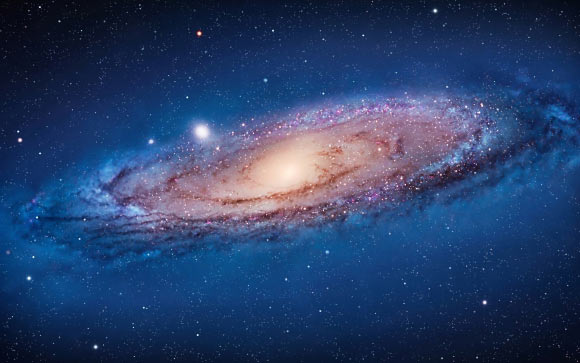The Andromeda galaxy, also known as Messier 31, collided and merged with a large galaxy approximately 2 billion years ago, according to new research. Even though it was mostly shredded, this large galaxy (with stellar mass about 2.5*1010 solar masses, the third-largest member of the Local Group, after the Milky Way and the Andromeda) left behind a rich trail of evidence: an almost invisible halo of stars, a giant stellar stream and the compact galaxy Messier 32.

In this image of the Andromeda galaxy, Messier 32 is visible to the upper-left of Andromeda’s center. Image credit: NASA.
Astronomers have long known that this nearly invisible large halo of stars surrounding galaxies contains the remnants of smaller cannibalized galaxies.
A galaxy like the Andromeda was expected to have consumed hundreds of its smaller companions. Scientists thought this would make it difficult to learn about any single one of them.
Using new computer simulations, University of Michigan astronomers Richard D’Souza and Eric Bell were able to understand that even though many companion galaxies were consumed by the Andromeda galaxy, most of the stars in the Andromeda’s outer faint halo were mostly contributed by shredding a single large galaxy.
“We realized we could use this information of Andromeda’s outer stellar halo to infer the properties of the largest of these shredded galaxies,” Dr. D’Souza said.
“Astronomers have been studying the Local Group for so long. It was shocking to realize that the Milky Way had a large sibling, and we never knew about it,” Professor Bell added.
This galaxy, called Messier 32p, which was shredded by the Andromeda galaxy, was at least 20 times larger than any galaxy which merged with the Milky Way over the course of its lifetime.
Messier 32p would have been massive, making it the third largest galaxy in the Local Group after the Andromeda and the Milky Way galaxies.
“This work might also solve a long-standing mystery: the formation of Andromeda’s enigmatic satellite galaxy,” the astronomers said.
“The compact and dense Messier 32 is the surviving center of the Milky Way’s long-lost sibling, like the indestructible pit of a plum.”
“Messier 32 is a weirdo,” Professor Bell said. “While it looks like a compact example of an old, elliptical galaxy, it actually has lots of young stars. It’s one of the most compact galaxies in the Universe. There isn’t another galaxy like it.”
“Our study may alter the traditional understanding of how galaxies evolve,” the researchers noted.
“The Andromeda’s disk survived an impact with a massive galaxy, which would question the common wisdom that such large interactions would destroy disks and form an elliptical galaxy.”
“The timing of the merger may also explain the thickening of the disk of the Andromeda galaxy as well as a burst of star formation 2 billion years ago, a finding which was independently reached by another team earlier this year.”
“The Andromeda galaxy, with a spectacular burst of star formation, would have looked so different 2 billion years ago,” Professor Bell said.
The study appears in the journal Nature Astronomy.
_____
Richard D’Souza & Eric F. Bell. The Andromeda galaxy’s most important merger about 2 billion years ago as M32’s likely progenitor. Nature Astronomy, published online July 23, 2018; doi: 10.1038/s41550-018-0533-x







